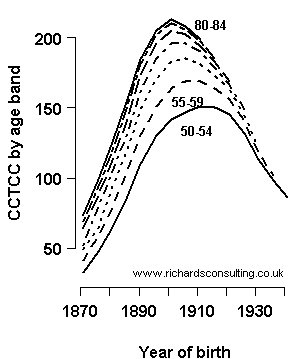A rose by any other name
How important are the labels we give to things? In a seminal paper Richard Willets brought a particular mortality phenomenon to the attention of the UK actuarial profession:
The 'cohort effect' has been a wave of rapid improvements, rippling upwards through mortality rates in the UK. For the past four decades, people born between 1925 and 1945 have benefited from faster mortality improvements than those born in adjacent generations.
Willets, R. C. (1999) Mortality in the next millennium,
Staple Inn Actuarial Society, London.
The cohort effect for UK mortality has been a major issue for pension liabilities. It has reduced mortality rates and thus pushed up the life expectancy for people in receipt of occupational pensions and annuities. Unsurprisingly, this has pushed up the reserves required by pension funds.
Some commentators have taken issue with the phrase "cohort effect", particularly the implied causal link to year of birth from using the word "effect". In the absence of irrefutable proof of such a link, such commentators question whether mortality rates should be projected by year of birth. In practice the cohort effect is simply a proxy for various underlying risk factors which do have direct causal impact on mortality. There are a number of such risk factors, of which perhaps the most prominent candidate is smoking, as shown in Figure 1:
Figure 1. Cumulative Constant Tar Cigarette Consumption for UK males by year of birth. Source: Lee et al (1990) and Forey et al (1993).

If one is being pedantic about the phrase "cohort effect", one should also point out the imprecision of the phrase "smoking". The figures behind Figure 1 are not of cigarettes smoked, but of "constant tar cigarette consumption". The tar content of cigarettes has varied over time, as has the use of filters, so a cigarette smoked today does not have the same impact on health as one smoked fifty years ago. The data behind Figure 1 have been adjusted to allow for this.
Correct naming and labelling is important in science, but we should never let it obscure the bigger picture. Whatever the underlying causes of the cohort effect, the fact is that there have been consistent mortality patterns by year of birth for the past four decades. Academics are free to argue over terminology and cause-and-effect, and whether projecting mortality by birth cohort is the correct thing to do. However, actuaries are obliged to act prudently in setting annuity and pension reserves and, noting a pronounced link between year of birth and mortality rates, they are professionally required to assume the link will continue in the future and reserve accordingly. Calling the "cohort effect" something else will not changes actuaries' obligations to continue projecting mortality improvements by year of birth.


Add new comment